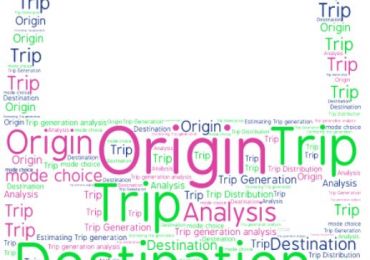What is trip generation ?
A trip is usually defined in transport modeling as a single journey made by an individual between two points by a specified mode of travel and for a defined purpose. Trips are often considered as productions of a particular land-use and attracted to other specified land-uses. The number of trips arises in unit time, usually for a specified zonal land use , is called the trip generation rate.
How to estimate trip generation ?
Trip generation is estimated in three ways:
(i) traditionally by linear and multiple regression
(ii) by aggregating the trip generating capability of a household or car and aggregating the total according to the distribution of each selected category in the zones, and
(iii) by household classification method through a catalogue of the characteristic mean trip rates for specific types of household.
The attraction points are identified as trip generated by work, and other purpose visits. By assigning suitable values to the independent variables of the regression equations forecasts can be made of the future trip ends for zones by either method.

Trip distribution:Trip generation estimates the number and types of trips originating and terminating in zones. Trip distribution is the process of computing the number of trips between one zone and all other. A trip matrix is drawn up with the sums of rows indicating the total number of trips originating in zone i and the sums of columns the total number of destinations attracted to zone j.
Each cell in the matrix indicates the number of trips that go from each origin zone to each destination zone. The trips on the diagonal are intra-zonal trips, trips that originate and end in the same zone. The balancing equation is implemented in a series of steps that include modeling the number of trips originating in each cases, adding in trips originating from outside the study area(external trips), and statistically balancing the origins and destinations.
This is done in the trip generation stage. But, it is essential that the step should have been completed for the trip distribution to be implemented. Two trip distribution matrices need to be distinguished. The first is the observed distribution. This is the actual number of trips that are observed traveling between each origin zone and each destination zone. It is calculated by simply enumerating the number of trips by each origin-destination combination. It is also called trip-link. The second distribution is a model of the trip distribution matrix, called the predicted distribution.
Generally trips should be distributed over the area proportionally to the attractiveness of activities and inversely proportional to the travel resistances between areas. It is assumed that the trips between zones will be by the most direct or cheapest routes and, taking each zone in turn, a minimum path is traced out to all other zones to form a minimum path tree. The trip distribution is a model of travel between zones-trips or links. The modeled trip distribution can then be compared to the actual distribution to see whether the model produces a reasonable approximation.
Read about: Zoning of Land for OD Survey, Traffic Volume Count, Origin Destination Survey Methods